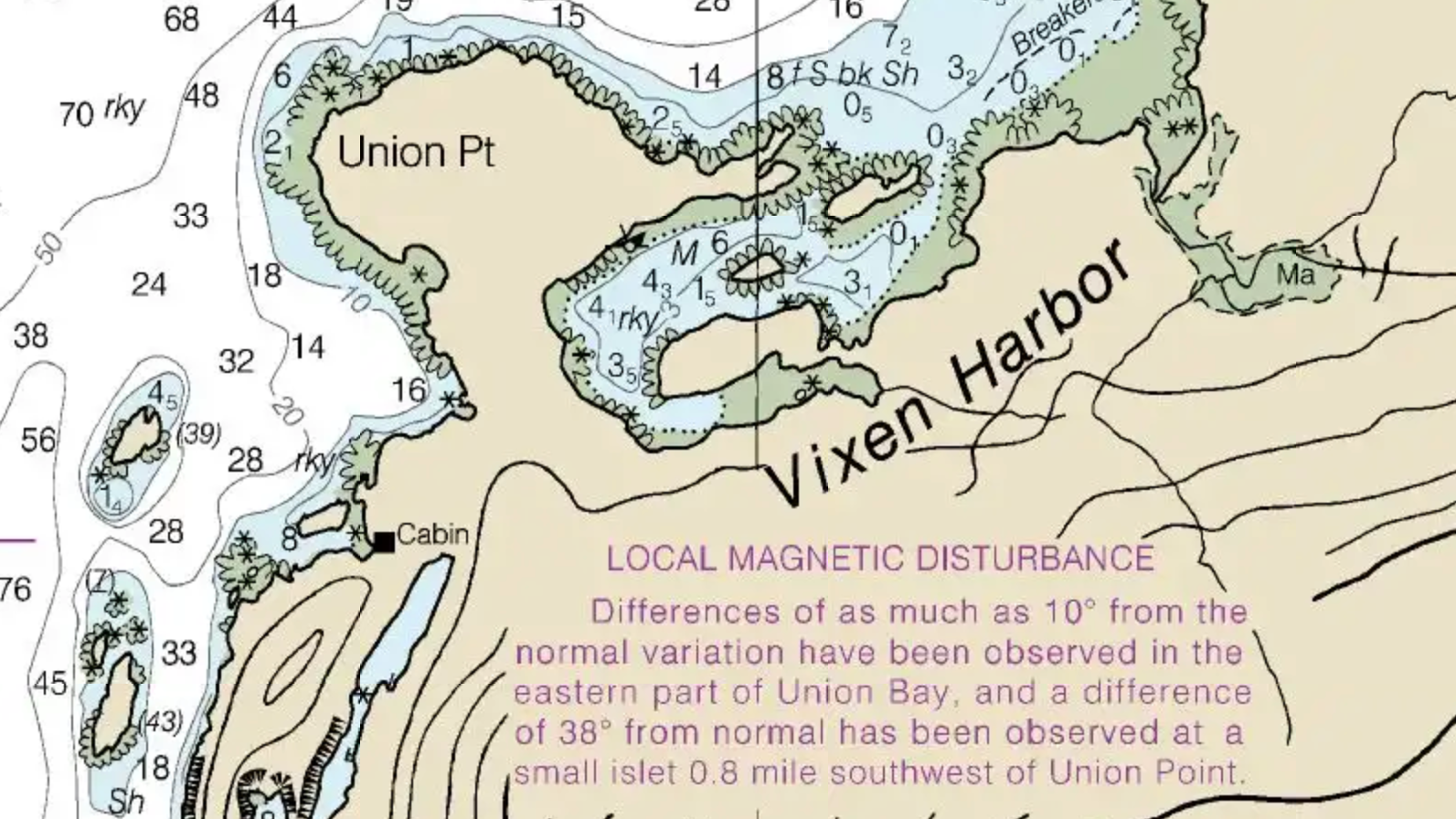When choosing navigation routes and anchorages, particularly in remote areas, there are numerous sources of information available to cruisers. There are paper and electronic charts, chartplotters, apps (such as Coastal Explorer, Navionics, and iNavX) for computers, smart phones, and tablets, as well as physical reference books. In SE Alaska, the books we typically use are (1) the Douglass’ guide “Exploring Southeast Alaska” and (2) “Charlie’s Charts North to Alaska.” One of our favorite guides, the Waggoner Cruising Guide, only goes as far north as Ketchikan, so it isn’t useful for most of the rest of Alaska. It is important not to trust any one of your sources implicitly, as often they have incomplete, misleading, and (in some cases) incorrect information.
The best way to protect yourself against wrong or misleading information is to:
(1) Be skeptical. Trust but verify with your own eyes, depth sounder, and other resources.
(2) Check multiple sources against each other. We use multiple types of charts, apps, and guide books. They often disagree.
(3) Understand where each source gets its original information. Is your source a primary source, or a derived source? If it’s a primary source, the person/organization providing the information actually visited and surveyed the location themselves. If it’s a derived source, the provider is reinterpreting information from another source without actually having been there.
Recently, we visited an anchorage in SE Alaska that we thought was a perfect case study for this. Airship was en route between Wrangell and Meyers Chuck. We decided we wanted to stay somewhere we hadn’t been before, and a spot called Vixen Harbor looked interesting to us. Vixen Harbor is a small harbor just south of the much larger Vixen Inlet. When you zoom in on the chart, Vixen Harbor looks like this (Garmin chart plotter, left, Navionics app on the iPad, right):
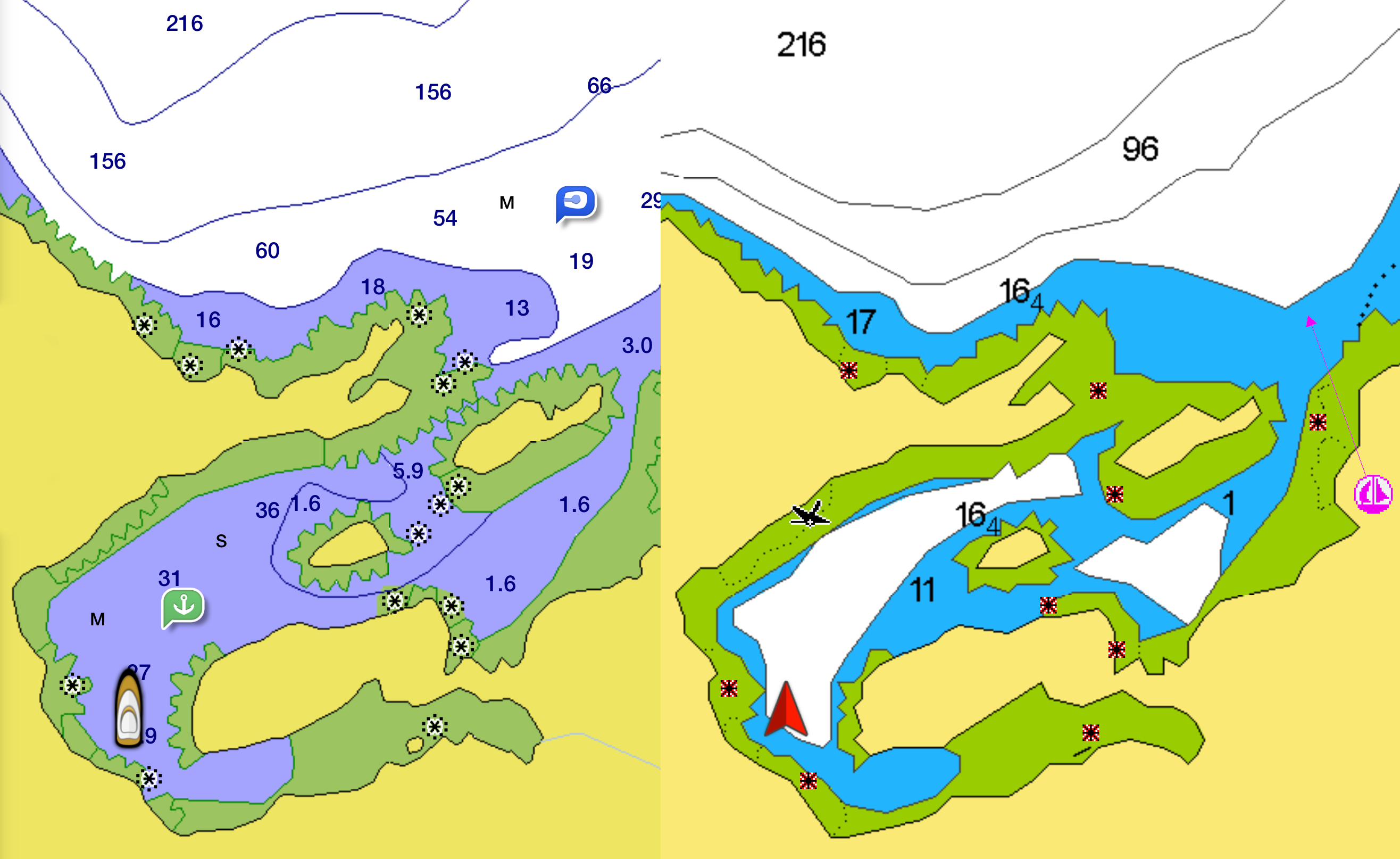
We know that Garmin and Navionics (and all chart plotter databases that we’re aware of) are derived sources. They get their base information from the NOAA charts, and then hire people to digitally interpret/reproduce it. That means the people who draw your Garmin map, for example, have almost certainly never been to the place you’re looking at on the map. They simply drew that picture by looking at the original NOAA chart.
NOAA charts, on the other hand, are primary sources based directly on government surveys. They are not always correct, but they are the most direct information we have from the cartographers who actually surveyed the area.
Here’s how the NOAA chart shows Vixen Harbor:

In this case, the NOAA chart is wrong (we’ll discuss how later) and both the Garmin and Navionics charts propagated the errors in the original NOAA chart.
First of all, looking at the charts for this anchorage, you’ve got to ask yourself if you’d even bother going in, right? And, we’re guessing you probably would not because one way in looks like it’s mostly or completely intertidal (green – meaning it’s dry land at zero tide) and the other side shows as 0 fathoms 1 foot on the original NOAA chart. Note that Garmin interprets this as 1.6 feet (for some reason), and Navionics interprets it as 1 foot. We interpret it as “don’t go in here at a zero tide!” Why even attempt it unless you’ve heard it’s AMAZING once you get in?
But say you’re curious, so you decide to do a little research. One of the easiest and quickest ways is via ActiveCaptain. ActiveCaptain is a crowd-sourced information resource that’s been around for several years. “Crowd-sourced” means the information in the app is supplied by comments and ratings left by other boaters who have visited, rather than by the creators of the guide. Crowd sourcing is a double-edged sword. On one hand, it’s nice to be able to get the opinions of several different boaters all in one place. On the other hand, you want to be careful how much trust to place in a post possibly penned by somebody’s Uncle Cletus who was riding along on his first boating trip ever and filling in the ActiveCaptain reviews as his crew duty.
The app runs on various mobile devices, and the database is also embedded in a number of chartplotters and chartplotter apps, such as Coastal Explorer. In 2017, ActiveCaptain was bought by Garmin, and as of mid-2018 is also now integrated into the Garmin chartplotter software.
While we love the idea of ActiveCaptain, we have several ethical and technical issues with it, which we’ll discuss later in this article, but for those reasons (in SE Alaska, at least) we often find that we often can’t rely on it for correct information. If you’re a fan of ActiveCaptain and you’re super bummed to hear this, here’s how to get around what we feel is the main problem with it: If there is only one ActiveCaptain entry for a location in SE Alaska, and it’s by “Kayley, Seattle”, ignore it and consult the Douglass guide instead. As far as we can tell, every post by “Kayley” is simply a poorly rewritten (or sometimes just straight copied-and-pasted) version of content from the Douglass guide that is then overly-embellished with often wrong or misleading information. If there are ActiveCaptain posts by anyone besides “Kayley”, treat them the same as you would any other crowd-sourced information. Think of it as Yelp! for boats. (Was that one-star reviewer a total jerk to the server and that’s why his service was bad, or was the other guy the server’s boyfriend and that’s why he gave the place five stars?) Anyway, we’ll talk more about “Kayley” later on.
For Vixen Harbor, there was only one post in ActiveCaptain and it was by “Kayley”. So we know (after many years spent visiting a large percentage of the SE Alaska anchorages covered in the Douglass guide and reading ActiveCaptain posts and Douglass guide entries about every single one of them) to ignore this entry and go straight to the Douglass guide. In other words, while ActiveCaptain is supposed to be a crowd-sourced primary source (written by boaters who have actually been there) the “Kayley” posts appear to us to be derived source information by somebody who hasn’t been there simply paraphrasing, embellishing, and sometimes just copy-and-pasting the Douglass guide entries.
We pull out the Douglass guide. The Douglass guide is a primary source, written by people who have actually visited these locations by boat. They say:
- The entrance channel is only 30 yards wide
- The entrance has a minimum depth of about one fathom or less at zero tide (not the 2 fathom depth described in Coast Pilot).
- You should not enter it in foul weather, in poor visibility, or under radar. Dangerous reefs extend well off the point and off the three small islets.
Note: “Kayley” in ActiveCaptain also says that that Vixen Harbor is an “adrenaline inducing piloting challenge” and “her” actual review in ActiveCaptain begins “Once you’ve navigated the white knuckle entrance the haror [sic] opens up…” Wow. “White knuckle” entrance?? Are we really up for THAT today?
Anyway. We digress.
As confusing as this all may seem at this point, we decided to pull out Charlie’s Charts. It’s a book we don’t look to all that often (that should change!) but we wanted another (real) person’s additional opinion on this place. It turns out, Charlie’s Charts has the most correct information of all.
“The entrance to Vixen Harbor is narrow and not obvious until it is carefully lined up, but it is a sheltered anchorage backed by a beautiful mountain. It is necessary to proceed about .25 to .5 miles off the coast until the entrance can be ascertained. When approaching, the eastern entrance is more obvious but do not attempt it for shoals make it unsafe to use. Line up the western entrance from offshore and steer carefully through using a mid-channel course. The pilot indicates a width of 30m (100 yards) but this may be the distance between high water shorelines. At low tide, reefs from both sides reduce the channel width to about 18m (60 ft.), but the depth is at least 1.5 fathoms. Once past the islands the harbor opens up nicely.”
Looking back at the chart, it actually LOOKS like the east entrance is better, right? The west entrance is all “green” intertidal – should be dry at zero tide. The east entrance is narrow, but shows about 1 ft at zero tide. That’s better than dry, isn’t it?
The charts are…just wrong. As we mentioned before, the NOAA raster chart is the source for both Garmin and Navionics, and the errors in the NOAA chart show up in both. The east entrance is actually a disaster – super shallow due to reefs and eelgrass growing up to the surface. The west entrance, on the other hand, has a nice wide-enough channel in a straight line with a depth of over 9 feet at zero tide.
Here’s a drone photo that shows both entrances at low tide. Note the problems with the east entrance on the left:
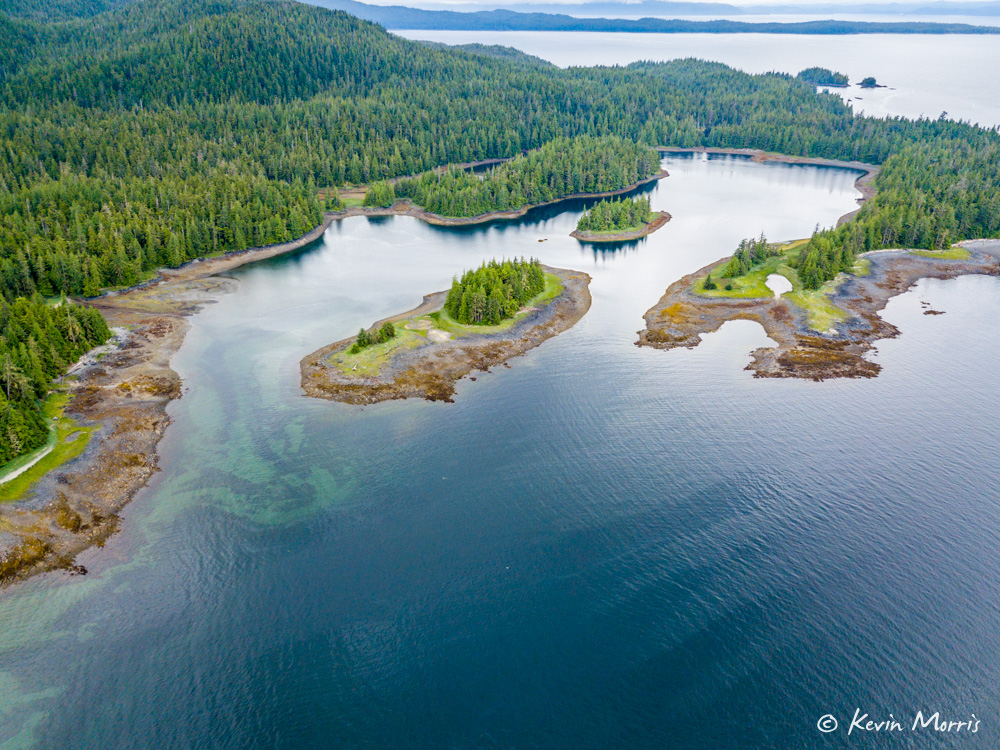
We went in a couple hours before low tide with about a 4 foot tide. The shallowest depth we saw on sonar was 13.7 feet, so with the 4 foot tide, that means the bottom at mid-channel was more than 9.7 feet at zero tide. Score a point for Charlie’s Charts.
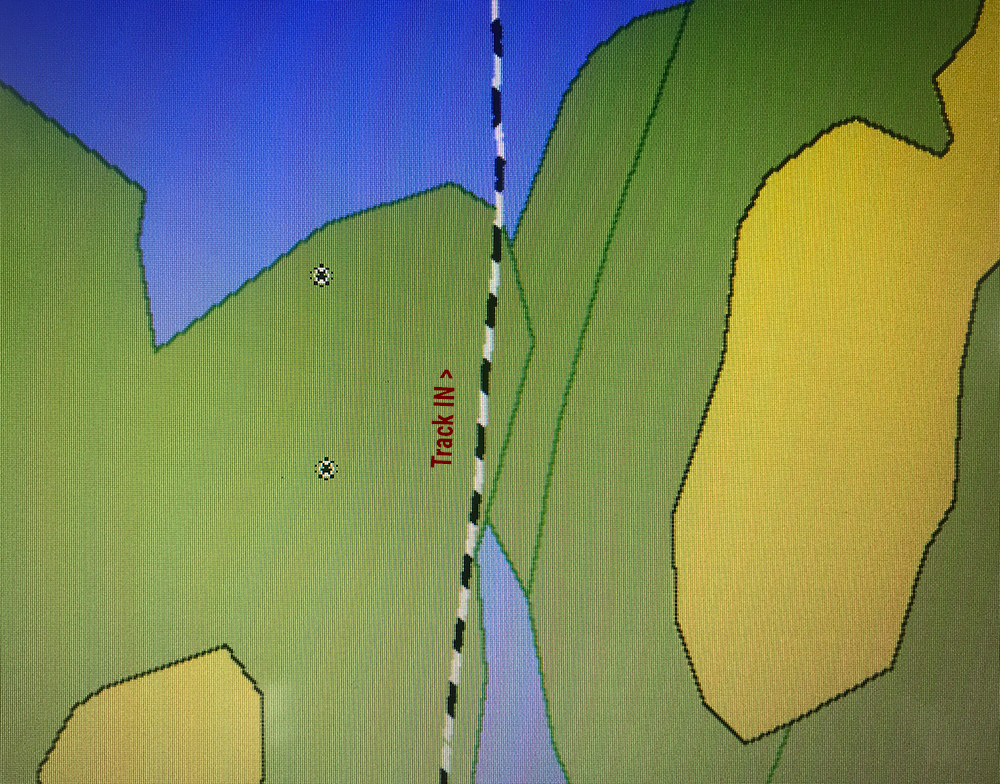
Why does the Douglass guide say it’s only 6 feet? On our way out, we left at high tide, and took a parallel path to our entry, but slightly off center.
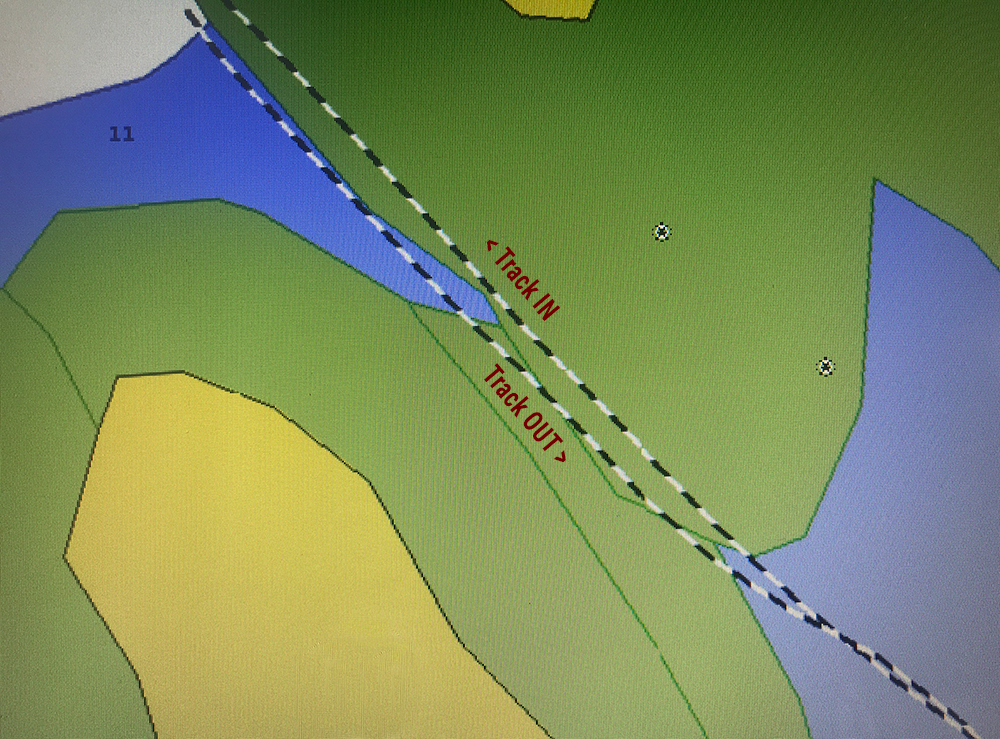
With a 10 foot tide, we saw a minimum depth on our depth sounder of 16 feet. So, if the Douglass folks were a few feet off center when they came in, they’d see a 9 foot zero-tide depth, just like they reported. It’s much easier to find the center of the channel at low tide when you can clearly see the shoals on both sides. But (of course) it’s safer to enter at higher tides when you’ve got more water under your keel.
Entry, even near low tide, was super easy. Just go slowly, follow your chartplotter, and keep a mid-channel course (which is pretty much a straight line). There was no “white knuckle” “adrenaline-inducing piloting challenge” involved. Here is a drone photo of the “good” west entrance at low tide (a 2.6 foot low, so the mid-channel depth here is probably just over 12 feet):
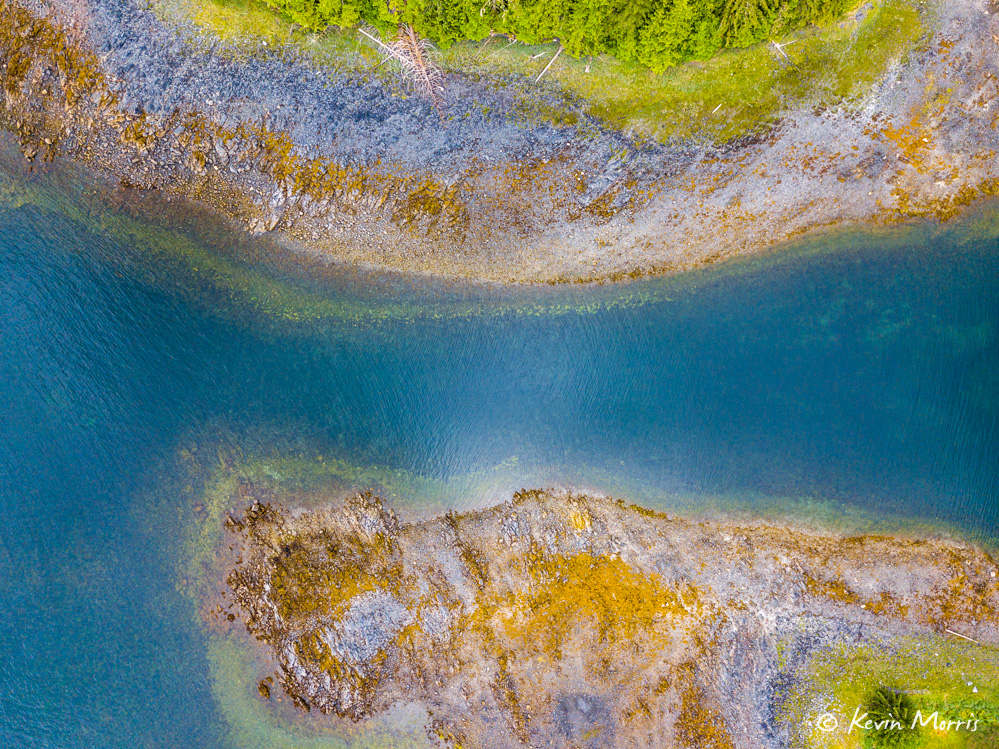
Epilogue: So, What’s the Deal with “Kayley”?
Our theory (which is just a theory) is that maybe the folks running ActiveCaptain wanted their database to cover Southeast Alaska. But, there was no information about Southeast Alaska in there (no boaters in the area were using the app yet, so nobody was adding any crowd-sourced information). In order to get crowd-sourcing started, there needs to be some “seed” info. It seems a reasonable assumption to us that somebody at ActiveCaptain could have taken the easy (and very unethical) way out and just created a fictitious “Kayley” account from which they posted basically the entire contents of the Douglass guide (without permission, of course). Or perhaps they had a friend do something similar. We really don’t know.
In order to disguise this scheme, the “Kayley” account seems to have paraphrased many, but not all of the entries and added additional superfluous information – usually random (and clearly fabricated) observations about wildlife. “Eagles circle overhead” is pretty easy in SE Alaska. That’s true everywhere. “Wolves can be heard howling in the distance”, however, which appears in many of “Kayley’s” posts is much more rare. In hundreds of nights anchored in SE Alaska, the Slowboat team has heard wolves – possibly – twice. Nobody has heard them at all the anchorages “Kayley” reports them in. Similarly, there are numerous reports of various types of wildlife that simply do not exist at the locations reported.
Why do we believe this? First, there is a daunting correlation between “Kayley” posts and the Douglass guide entries. You can play this game yourself at home. Look in ActiveCaptain and choose pretty much any “Kayley” post in SE Alaska. Then look up the same location in the Douglass guide. You’ll generally find exactly the same observations in the same order (except for the added weird wildlife stuff mentioned above). You’ll find the same errors – if the Douglass folks missed the depth by 3 feet, remarkably “Kayley” does too (but in fathoms). Additionally, if the Douglass folks (oddly) mention the water temperature of a place, “Kayley” will too. You’ll almost never find a “Kayley” post for any location not covered by the Douglass guide, and you’ll almost never find any substantive information given in any “Kayley” post that’s not also in the Douglass guide.
Since we’ve been discussing Vixen Harbor, let’s just try our game with this one!
Douglass: “We found entering Vixen Harbor more difficult than described in Coast Pilot.”
ActiveCaptain/Kayley: “Coast Pilot 8 is useful but understates the challenge to enter the harbor.”
——————-
Douglass: “The entrance channel is quite narrow–we figure about 30 yards or less, not the 100 yards mentioned in Coast Pilot–and the depth is not 2 fathoms as noted… As closely as we can determine the channel has a minimum depth of about one fathom or less at zero tide.”
ActiveCaptain/Kayley: “The entrance channel is less than 30 yards and we found the depth at zero tide to be 6 feet, not the 12 feet which CP indicates.” (Note: almost any time Douglass uses fathoms, AC/Kayley switches to feet, and vice versa. Clever!)
——————-
Douglass: “You should not enter it in foul weather, in poor visibility, or under radar. Dangerous reefs extend well off the point and off the three small islets.”
ActiveCaptain/Kayley: “We recommend not attempting to enter nor leave this area in foul weather. Using radar for a night approach is also not recommended.”
——————-
Douglass: “Vixen Harbor offers good shelter and gives you a feeling of security.”
ActiveCaptain/Kayley: “Once inside, however, you’ll be protected from anything mother nature can throw at you.”
——————-
Douglass: “Birds and seals like this shelter, too!”
ActiveCaptain/Kayley: [Here’s where Kayley’s embellishing prowess really shines!] “A large colony of seals will keep you company as the islets at the entrance tends [sic] to be there [sic] home. A large variety of waterfowl is also present within the harbor. Bald eagles and gulls dominate the sky [duh, pretty much a sure bet anywhere in SE Alaska] while wolves can be heard in the distance.” [No, they can’t, but Kayley adds this “wolves howling in the distance” thing to almost every post!]
——————-
Douglass: “The harbor bottom is mostly flat with room enough for several boats.”
ActiveCaptain/Kayley: “Once you’ve navigated the white knuckle entrance the haror [sic] opens up into a large setting which could accommodate several boats, though we’ve always been alone here [or perhaps we’ve never been here at all because we’re not even a real person?]”
——————-
Douglass: “Anchor in 4 fathoms over soft, sticky mud and sand with very good holding.”
ActiveCaptain/Kayley: “Anchor in 24 to 45 feet with excellent holding over a sticky mud bottom.”
——————-
You see what we mean, don’t you? How “Kayley” almost always makes the same points as the Douglass guide in the same order? And, the wording sounds strangely similar to the Douglass guide, doesn’t it? The Douglasses mention birds and seals, “Kayley” mentions birds and seals. The Douglass guide (oddly) mentions the water temperature of an anchorage in one post, guess what? “Kayley” mentions the water temperature of that SAME anchorage in her ActiveCaptain entry. It’s eerie, isn’t it?
This is not an isolated example, nor is the most egregious. You’ll find the same thing if you compare just about any “Kayley” post (and there are hundreds) with a Douglass entry.
Whoever created all the “Kayley” posts spent probably hundreds of hours just entering the data. One has to wonder why a random, unpaid boater would spend that much time paraphrasing, copying, and pasting guidebook information into an app – without adding any real information from their own (supposedly extensive) firsthand experience. What did they stand to gain? And, if they were going to add Douglass guide information into their posts, why didn’t they attribute it (like we did above – The Douglass guide says “blah blah blah”)?
Finally, more telling is an anchorage around the corner from Vixen Harbor, which the Douglass guide calls “Magnetic Cove.” The Douglass folks write “‘Magnetic Cove’ is our name for the long narrow cove behind Magnetic Point.” Well now, this is a problem if you’re making a “Kayley” post. After all – if you use the name that the Douglasses INVENTED, it’ll be pretty clear that you’re copying from there, right? So of course “Kayley” invented a similar but different name for the place — she calls it “Mesmeric Cove” (rhymes with “magnetic”!!). Of course, we can’t find any chart or any primary source that use “Mesmeric Cove” as the name for this location. “Kayley” says “This area begs you to come explore, thus our name for the anchorage.”
The community of recreational boaters in SE Alaska is very small. There is seldom more than one degree of separation between any two boats you might randomly run into and in fact, we run into the same boats and the same people over and over each summer. Remarkably, in all of our cumulative years cruising SE Alaska, we’ve never met a single boater who has ever even heard of a real life “Kayley” from Seattle. That’s pretty telling in itself, because as the title of a book we recently read about a small town (Haines) in SE Alaska says: “If You Lived Here, I’d Know Your Name” (by Heather Lende).
Now, does Garmin know that when they bought ActiveCaptain, they also probably bought a big ‘ol pile of copyright violations? Probably not. If they figure it out, (or if someone sues them) it will be interesting to see if the “Kayley” posts magically disappear.
Of course we’d love it if “Kayley” was really Kayley the real person/boater who’d actually visited all these places, and our suspicions about ActiveCaptain were just some bloated conspiracy theory we dreamed up while cruising Grenville Channel one day. Our team has tried in the past to get contact information for Kayley, but to no avail. So, if anybody knows “Kayley, Seattle (19923)” from ActiveCaptain, give a shout out in the comments below. We’d love to buy her a bottle of (good) champagne and apologize. 🙂
Just to reiterate, we don’t have a horse in this copyright race — it’s not our problem and as we said above, we like and use ActiveCaptain. Yes, we’re personally annoyed when people don’t respect the intellectual property of others, but our primary concern is that these errors can be misleading and in some situations possibly dangerous. If you assume that a source like Kayley/ActiveCaptain was written by a person who was actually THERE, but instead what you’re getting is a slightly altered and sometimes incomplete or incorrect version of a primary source (that also could be incomplete), then you could end up putting your vessel or yourself in danger unnecessarily.
For example, there’s an anchorage that Sam visited recently on Etolin Island (McHenry) where the Douglass guide neglects to mention that a large part of the charted “good anchorage area” is actually a large rocky reef at low tide. Perhaps the Douglass folks only visited briefly at high tide and never saw the rocky reef. But when someone else subsequently asserts that they have stayed there and also doesn’t mention this rocky reef (which they definitely would have noticed if they actually anchored overnight there) then there are three sources (Douglass, ActiveCaptain, and the NOAA chart) giving the same, incomplete information in a way that makes a new visitor, having researched the location and read what they believe to be two firsthand accounts, feel more confident than is prudent.
Addendum — July 15, 2018: In some of the response to this article in various forums, people have advocated looking at a number of reviews (for a single location) in ActiveCaptain as the best strategy for getting a complete picture. SE Alaska is remote and lightly traveled. It is not like the East Coast where you frequently have 30 or more reviews by different boaters about the same location. Unfortunately, in many (if not the majority) of anchorages in SE Alaska, posts by “Kayley” (which are substantially identical to corresponding entries in the Douglass guide), are the ONLY post in ActiveCaptain for that location. And, given that the “Kayley” posts are usually the first post for every location in SE Alaska, it’s fair to assume that without the “Kayley” posts, ActiveCaptain would have little to no coverage of SE Alaska at all.

